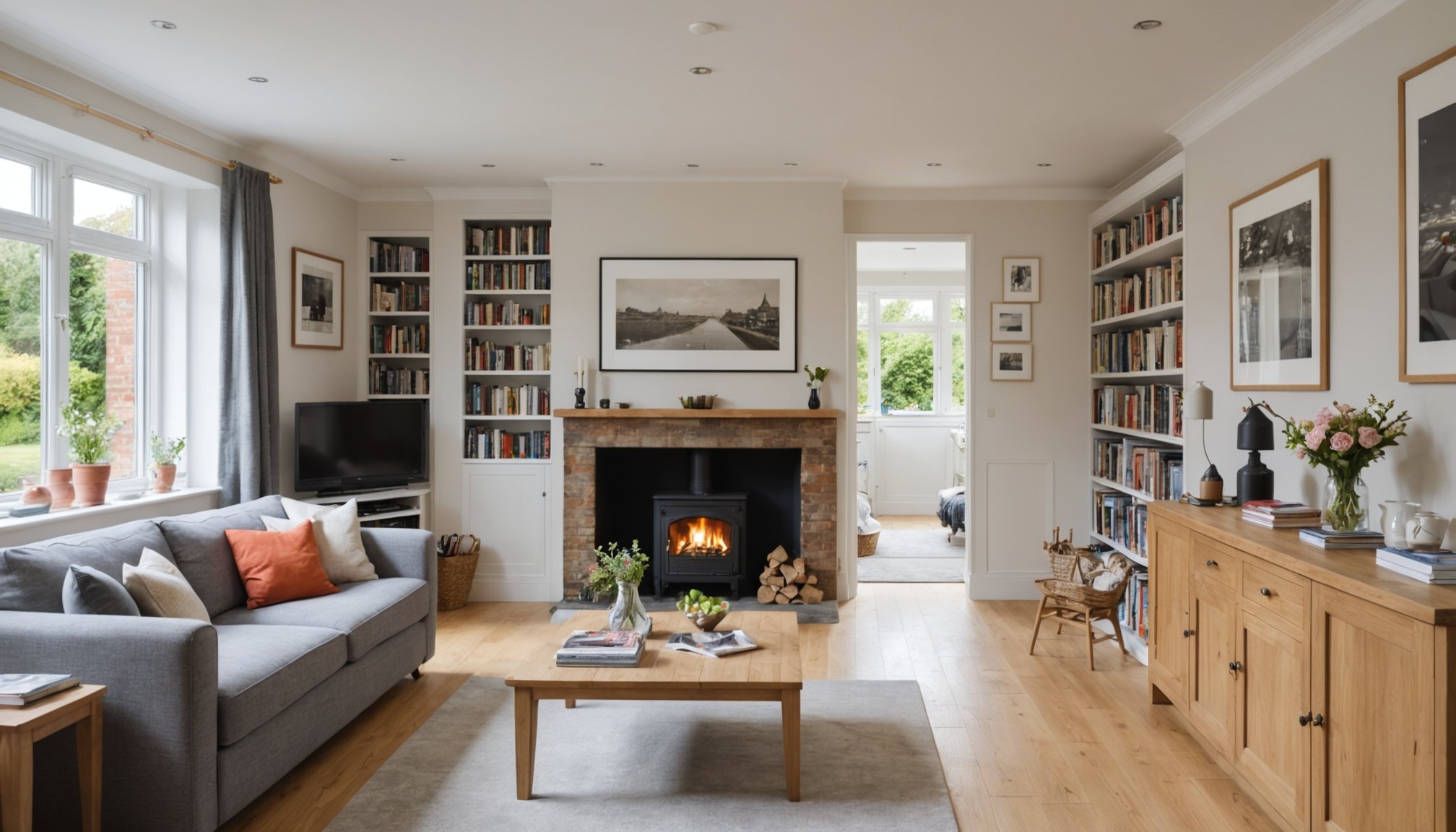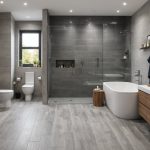A large family can thrive in a three-bedroom UK home with ingenuity and thoughtful design. Rather than considering extensions, explore innovative space-saving solutions that enhance functionality and comfort. By embracing multi-purpose furniture, rethinking room layouts, and utilizing vertical space, you can create an environment that maximizes every square inch. Discover how to transform your home into a harmonious living space, tailored to your family's needs, without the hassle or expense of construction.
Innovative Space-Saving Ideas
In family home organization, space-saving solutions are essential for maintaining a clutter-free environment. One effective strategy is utilizing vertical space through shelving and wall-mounted storage. By installing shelves or cabinets on walls, you can free up floor space and keep items easily accessible. This approach is particularly beneficial in smaller rooms where every inch counts.
Sujet a lire : Transform Your Small UK Urban Backyard into a Tranquil Zen Garden: A Step-by-Step Guide
Another smart choice is investing in foldable and extendable furniture. These pieces are designed to adapt to your needs, providing flexibility in how you use your space. For instance, a foldable dining table can be expanded for family gatherings and then compacted when not in use, maximizing available space.
The creative use of under-bed storage is another excellent way to maximize floor space. By using storage bins or drawers that fit under the bed, you can store seasonal clothing, extra bedding, or other items that aren't needed daily. This method keeps your belongings organized and out of sight, contributing to a tidy and spacious home environment.
A lire également : Transform Your UK Semi-Detached Home with Solar Roofs: Aesthetic Solutions for Seamless Installation
These space-saving solutions not only help in organizing a family home but also enhance the overall functionality and aesthetic appeal of your living spaces. Embracing these ideas can lead to a more efficient and enjoyable home life.
Multifunctional Room Usage
In today's homes, multifunctional rooms are gaining popularity due to their ability to maximize space and utility. Designing rooms to serve dual purposes, such as a guest room that doubles as an office, is a practical approach. This strategy allows you to accommodate guests without sacrificing a dedicated workspace. By incorporating furniture that can easily transition between uses, such as a sofa bed or a foldable desk, you can seamlessly switch between functionalities.
Flexible living spaces are also essential for families, especially those with children. Integrating play areas within living spaces encourages family engagement and ensures that children have a designated space for activities. This can be achieved by using modular furniture or storage solutions that can be rearranged to create a safe and enjoyable play environment.
Creating temporary partitions is another effective method to define areas as needed. These partitions can be in the form of sliding doors, curtains, or movable screens, offering privacy and separation without permanent alterations. This flexibility is particularly beneficial in open-plan homes, allowing you to tailor the space according to your current needs. By embracing these ideas, you can enhance the functionality and adaptability of your home, making it a truly versatile living environment.
Furniture Arrangement Tips
Arranging furniture effectively is crucial for space optimization and creating a harmonious living environment. The right furniture layout enhances flow and accessibility, making daily activities more enjoyable. Start by positioning larger pieces, like sofas or beds, against walls to maximize open space. This approach not only improves movement but also creates a welcoming atmosphere.
In open-plan spaces, defining zones for different activities is essential. Consider using area rugs or distinct furniture groupings to delineate spaces for dining, relaxation, or work. This technique helps in organizing activities without the need for physical barriers, maintaining an open and airy feel.
Scale and proportion are vital when selecting furniture. Oversized pieces can overwhelm a room, while too-small items may look out of place. Choose furniture that complements the room's dimensions, ensuring a balanced and cohesive look. For instance, in a smaller room, opt for multi-functional furniture that doesn't compromise on style or functionality.
When arranging furniture, remember to leave enough room for easy movement. Pathways should be clear and wide enough to navigate comfortably. By following these best practices, you can enhance the functionality and aesthetics of your home, making it a more enjoyable place to live.
Storage Solutions for Families
In family homes, creative storage solutions are key to maintaining an organized living space. When it comes to toys and children's items, consider using colourful bins or baskets that can be easily accessed and moved around. This not only keeps the play area tidy but also teaches children the importance of organizing their belongings.
Multifunctional furniture with built-in storage is another excellent option for families. Pieces such as ottomans with hidden compartments or beds with drawers underneath offer discreet storage without compromising on style. These items serve dual purposes, making them ideal for maximizing space in shared family areas.
Implementing a family calendar and organization system can significantly enhance the efficiency of shared spaces. A wall-mounted calendar in a common area helps keep track of everyone's schedules and commitments, reducing the likelihood of missed appointments or double bookings. Additionally, having a designated spot for keys, mail, and other essentials ensures that these items are always easy to find.
By integrating these family storage ideas into your home, you can create a more organized and harmonious living environment. These strategies not only help in managing clutter but also promote a sense of responsibility and teamwork among family members.
DIY Projects for Space Maximization
Transforming your home into a more efficient space doesn't always require a professional touch. With some DIY home projects, you can create creative home solutions that cater to your family's unique needs.
Start with simple projects like customizing storage options. For instance, building wall-mounted shelves from reclaimed wood not only adds character but also maximizes vertical space. These shelves can be tailored to fit any room, providing a personalized touch that meets your storage requirements.
Repurposing furniture is another ingenious way to enhance functionality. Consider converting an old dresser into a chic kitchen island by adding a countertop and wheels. This project not only breathes new life into unused furniture but also provides additional storage and workspace in the kitchen.
For those on a budget, small hacks can make a big difference. Use tension rods to create extra hanging space in closets or under sinks. These rods are inexpensive and easy to install, offering a quick fix for cluttered areas.
By embracing these budget-friendly hacks, you can significantly improve space efficiency in your home. With a bit of creativity and effort, your DIY projects can lead to a more organized and enjoyable living environment.
Real-Life Examples and Case Studies
In the realm of family home examples, real-life transformations highlight the impact of successful space organization. One notable case study involves a family of four living in a compact three-bedroom home. By implementing thoughtful design strategies, they managed to maximize their space efficiently.
Case Study: The Johnson Family
Facing clutter and limited space, the Johnsons opted for a comprehensive reorganization. They introduced vertical storage solutions and multifunctional furniture, such as a sofa bed and a dining table with storage compartments. This approach not only decluttered their living area but also created a more harmonious environment.
Testimonials from Families
Families who have undertaken similar projects often share positive feedback. One mother noted, "Integrating storage into our furniture was a game-changer. It made our home feel more open and accessible." These testimonials underscore the practicality and satisfaction derived from effective space management.
Visual Transformations
Before-and-after images serve as powerful illustrations of these changes. For instance, a cluttered living room can be transformed into a sleek, organized space with clearly defined zones for relaxation and play. These visual examples inspire others to embark on their own space-saving journeys, showcasing the tangible benefits of strategic home organization.
Child-Friendly Design Considerations
Creating child-friendly homes involves thoughtful design that balances safety, functionality, and playfulness. In communal spaces, incorporating elements that cater to children's needs is essential. For instance, consider setting up a dedicated play area with soft mats and accessible storage for toys. This not only encourages play but also keeps the space organized.
Safety is paramount in family-friendly design. Choose furniture with rounded edges and secure heavy items to walls to prevent tipping. Opt for non-slip rugs and ensure that electrical outlets are covered. These precautions help create a safe environment where children can explore freely.
Incorporating playful elements can make a home more engaging for children while optimizing space. Consider using wall decals or chalkboard paint for creative expression. Shelving at a child’s height allows easy access to books and toys, promoting independence.
Additionally, multifunctional furniture, like a bench with storage, can serve dual purposes, providing seating and a place to keep toys. These thoughtful design choices ensure that homes are both practical and enjoyable for families. Embracing these strategies fosters a nurturing environment where children can thrive.












